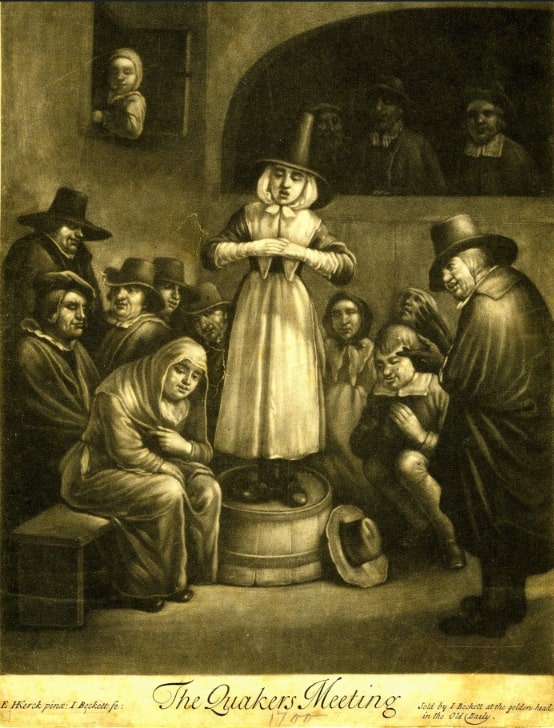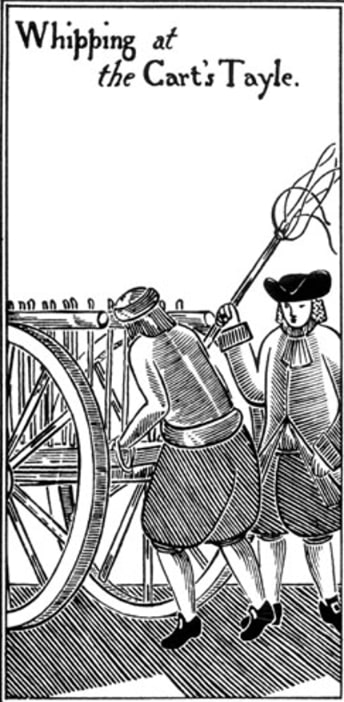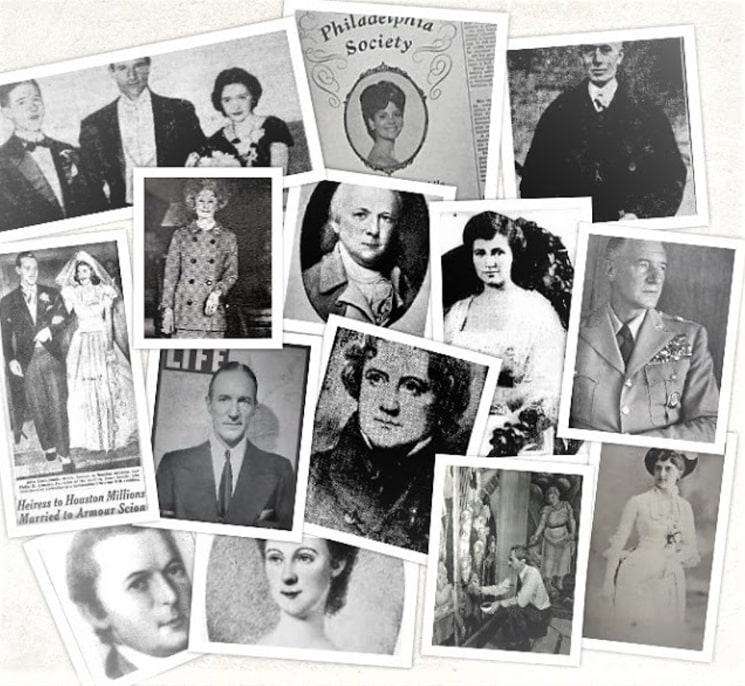Introduction: In this article, Melissa Davenport Berry continues her series describing three brave Quaker women who defied Puritan officials in Massachusetts Bay Colony in the 1600s. Melissa is a genealogist who has a website, americana-archives.com, and a Facebook group, New England Family Genealogy and History.
Today I continue my series focusing on three brave 17th century Quaker women: Lydia Wardwell, Deborah Wilson, and Margaret Brewster. They were among the many dames who protested the orthodox Puritans in Massachusetts Bay Colony in the 1600s.
The following illustration shows a Quaker woman with a tall hat standing on a half barrel, her hands clasped, surrounded by other Quakers. Quaker women in the 17th century were men’s equals in the Society of Friends, a concept intolerable to the Puritans.

To recap: In 1663 Quakeress Lydia (nee Perkins) Wardwell of Hampton, New Hampshire, wife of Eliakim Wardwell, went naked into Newbury Meeting House to protest the actions of Puritan officials.
According to the Ipswich Antiquarian Papers, Lydia and her husband had been reduced to almost total destitution by persecution because they were Quakers. She was summoned (by the church where she had been a member before becoming a Quaker) to appear and answer the charge of non-attendance. She obeyed the call by appearing in the unclothed condition of the sufferers – fellow persecuted Friends – whom she had seen under the constable’s whip. (Read more in Part One.)
Along with the court records, Lydia’s sentence appears in this newsclip.

This article reports:
“On the records of the Court at Salem, I find the following, vis. ‘May 5th, 1663, Lydia Wardwell, on her presentment for coming naked into Newbury meeting house, the sentence of the Court is, that she be severely whipped, and pay the costs and fees to the marshall of Hampton for bringing her. Costs ten shillings, fees two shillings and sixpence.’”
Lydia’s punishment from the authorities took place at the Ipswich tavern. She was stripped to the waist, tied to a post, and writhed under the lash, severely scourged to the satisfaction of the lookers-on at the tavern.
Her husband Eliakim suffered his own punishment by the whip. According to George Bishop in New England Judged:
Eliakim was sentenced to be stripped from his waist upward, and to be bound to an oak tree that stood by their worship-house, and to be whipped fifteen lashes. (p. 241)
Whipping was a punishment many Quakers endured at the hands of the Puritans, sometimes tied to a post or tree, often tied to the tail end of a cart.

To dodge the fussbudget herds, the Wardwell clan moved to Shrewsbury, New Jersey. Eliakim became one of the first Quaker ministers in the town. They were the founders and first settlers of the New Jersey coastal area today known as Monmouth Beach. There is a map of the settlement known as Wardell’s Beach.
Perhaps the family gained some satisfaction with the belief that the judgment of Heaven would fall upon their persecutors (a belief shared by the Puritans).
It is bemusing to think that the Puritans, who left Mother England to escape religious persecution, would inflict such brutal torment on the Quakers for their religious beliefs.
Even more of a mystery is the whereabouts of Lydia’s petticoat. According to Quaker poet John Greenleaf Whittier, it was left for safekeeping with Gov. John Easton, who must have grabbed it after Lydia was wrapped in cloth and shuffled off very abruptly from the Newbury Meeting House without her garments.
Though her petticoat may never be found, Lydia Wardwell certainly taught us that the naked truth is always better than a well-dressed lie.
Some notable Perkins-Wardwell descendants and kin relations include: convicted Salem witch Mary Perkins Bradbury; author and “Mayflower Madam” Sydney Biddle Barrows; the statesman, brewer, governor and Declaration of Independence signer Samuel Adams; actor James Dean; actress Lucille Ball; and four U.S. presidents – Millard Fillmore, Calvin Coolidge, Franklin Roosevelt, and Richard Nixon.

Stay tuned for the next Quaker lass story!
Explore over 330 years of newspapers and historical records in GenealogyBank. Discover your family story! Start a 7-Day Free Trial
Note on the header image: “Cassandra Southwick in court before the magistrates,” from the Boston Globe, 23 October 1923.
Related Articles:
- 17th Century Quaker Women Gone Wild (part 1)
- Nathaniel Sylvester, ‘Lord of Shelter’ for 17th Century Quakers
- A Monument for Persecuted Quakers Upsets Salem, MA
- Persecuted Quakers in Colonial America
- Persecuted Quakers in Colonial America, Part II
- The Coming of the Quakers Part I and Part II
- Early Quaker Meetings Raided by Salem Authorities
- Quaker Trailblazers: The Unconventional Biddles
- The 1st Generation of Philadelphia Biddles & the Scull Family
